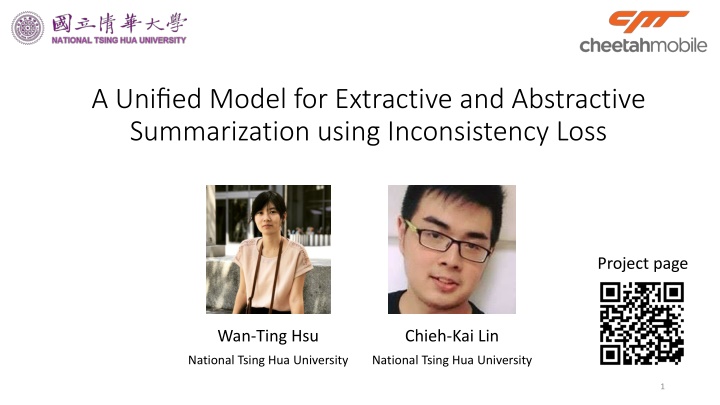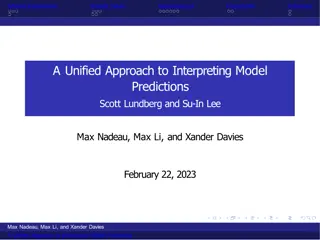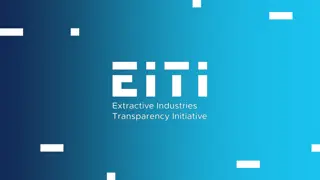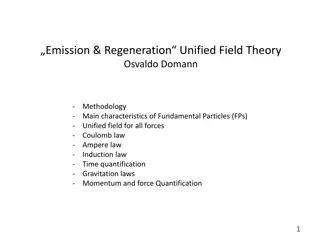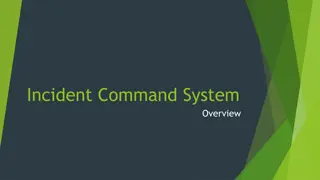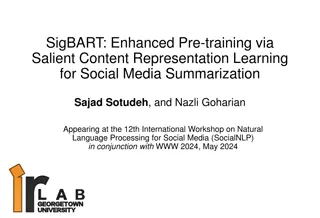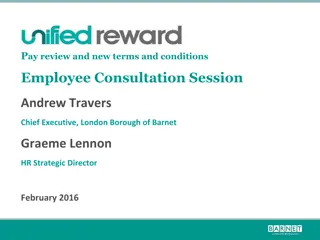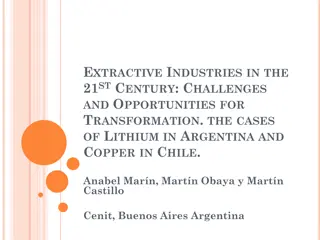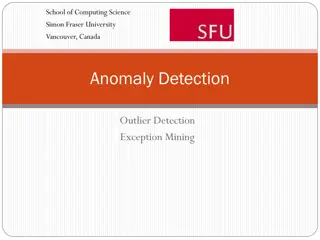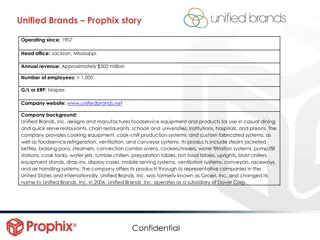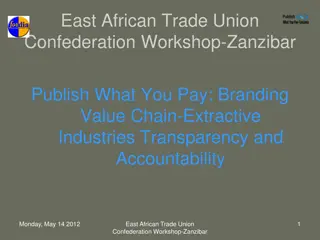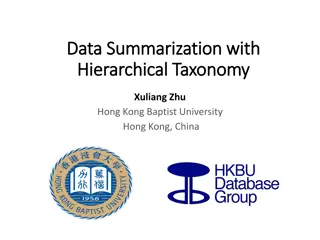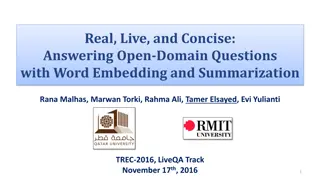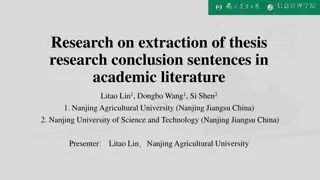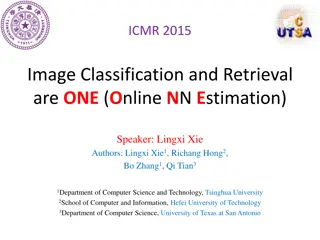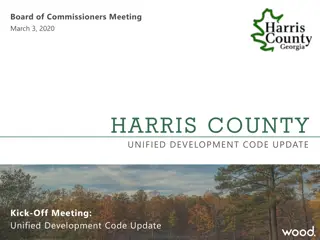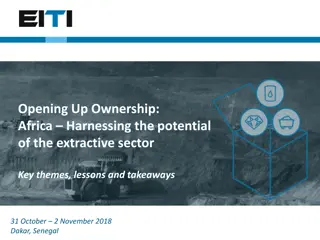Unified Model for Extractive and Abstractive Summarization
This project proposes a unified model that combines both extractive and abstractive summarization techniques using an inconsistency loss. The approach involves training procedures to enhance the summarization process and presents experimental results demonstrating its effectiveness. The study concludes on the effectiveness of the unified model in generating concise summaries while preserving important content.
Download Presentation

Please find below an Image/Link to download the presentation.
The content on the website is provided AS IS for your information and personal use only. It may not be sold, licensed, or shared on other websites without obtaining consent from the author.If you encounter any issues during the download, it is possible that the publisher has removed the file from their server.
You are allowed to download the files provided on this website for personal or commercial use, subject to the condition that they are used lawfully. All files are the property of their respective owners.
The content on the website is provided AS IS for your information and personal use only. It may not be sold, licensed, or shared on other websites without obtaining consent from the author.
E N D
Presentation Transcript
A Unified Model for Extractive and Abstractive Summarization using Inconsistency Loss Project page Wan-Ting Hsu Chieh-Kai Lin National Tsing Hua University National Tsing Hua University 1
Outline Motivation Our Method Training Procedures Experiments and Results Conclusion 2
Outline Motivation Our Method Training Procedures Experiments and Results Conclusion 3
Overview Textual Media People spend 12 hours everyday consuming media in 2018. eMarketer https://www.emarketer.com/topics/topic/time-spent-with-media 4
Overview Text Summarization To condense a piece of text to a shorter version while maintaining the important points 5
Overview Examples of Text Summarization Article headlines Meeting minutes Movie/book reviews Bulletins (weather forecasts/stock market reports) 6
Overview Automatic Text Summarization To condense a piece of text to a shorter version while maintaining the important points Extractive Summarization Abstractive Summarization select text from the article generate the summary word-by-word 7
Overview Extractive Summarization Select phrases or sentences from the source document Representation sentence 1 1 3 9 2 sentence 2 5 6 5 7 sentence 3 8 1 1 4 - - - - Shen, D.; Sun, J.-T.; Li, H.; Yang, Q.; and Chen, Z. 2007. Document summarization using conditional random fields. IJCAI 2007. K geb ck, M., Mogren, O., Tahmasebi, N., & Dubhashi, D. Extractive Summarization using Continuous Vector Space Models. EACL 2014. Cheng, J., and Lapata, M. Neural summarization by extracting sentences and words. ACL 2016. Ramesh Nallapati, Feifei Zhai, and Bowen Zhou. Summarunner: A recurrent neural network based sequence model for extractive summarization of documents. AAAI 2017 8
Overview Abstractive Summarization Select phrases or sentences from the source document Article Encoder Decoder Representations - - Alexander M Rush, Sumit Chopra, and Jason Weston. A neural attention model for abstractive sentence summarization. EMNLP 2015. Ramesh Nallapati, Bowen Zhou, Cicero dos Santos, Caglar Gulcehre, and Bing Xiang. Abstractive text summarization using sequence- tosequence rnns and beyond. CoNLL 2016. Abigail See, Peter J Liu, and Christopher D Manning. Get to the point: Summarization with pointergenerator networks. ACL 2017. Romain Paulus, Caiming Xiong, and Richard Socher. A deep reinforced model for abstractive summarization. ICLR 2018. Fan, Angela, David Grangier, and Michael Auli. Controllable abstractive summarization. arXiv preprint arXiv:1711.05217 (2017). - - - 9
Overview Motivation not concise Extractive summary (select sentences): important, correct incoherent or not concise Italian artist Johannes Stoetter has painted two naked women to look like a chameleon. The 37-year-old has previously transformed his models into frogs and parrots but this may be his most intricate and impressive artwork to date. Abstractive summary (generate word-by-word): readable, concise may lose or mistake some facts concise Justin Bieber Johannes Stoetter has previously transformed his models into frogs and parrots but this chameleon may be his most impressive artwork to date. Unified summary: important, correct readable, concise 10
Outline Motivation Our Method Training Procedures Experiments and Results Conclusion 11
Method Models Extractor Abstracter static sentence attention dynamic word attention Ramesh Nallapati, Feifei Zhai, and Bowen Zhou. Summarunner: A recurrent neural network based sequence model for extractive summarization of documents. AAAI 2017 Abigail See, Peter J Liu, and Christopher D Manning. Get to the point: Summarization with pointer-generator networks. ACL 2017 12
Method Combined Attention Extractor Abstracter static sentence attention dynamic word attention ? ? ?: word index ?: sentence index ?: generated word index 13
Method Combined Attention Extractor Abstracter static sentence attention dynamic word attention ?1 ?3 ?2 ?2?3 ?4?5?6?7?8?9 ?1 Cindy is lucky. She won $1000. She is going to ?: word index ?: sentence index ?: generated word index 14
Method Combined Attention Our unified model combines sentence-level and word-level attentions to take advantage of both extractive and abstractive summarization approaches. 15
Method Combined Attention Updated word attention is used for calculating the context vector and final word distribution 16
Method Encourage Consistency We propose a novel inconsistency loss function to ensure our unified model to be mutually beneficial to both extractive and abstractive summarization. multiplied attention of top K attended words maximize 17
Method Encourage Consistency encourage consistency of the top K attended words at each decoder time step. inconsistency loss: consistent < inconsistent 1.0 consistent inconsistent K = 2 0.5 Sentence 2 Sentence 3 Sentence 1 18
Method Encourage Consistency encourage consistency of the top K attended words at each decoder time step. 1.0 consistent inconsistent consistent K = 2 0.5 Sentence 2 Sentence 3 Sentence 1 19
Outline Motivation Our Method Training Procedures Experiments and Results Conclusion 20
Training Procedures Extractive Summarization Abstractive Summarization select sentences from the article generate the summary word-by-word 21
Training Procedures 3 types of loss functions: 1. extractor loss 2. abstracter loss + coverage loss 3. inconsistency loss 22
Training Procedures 3 types of loss functions: 1. extractor loss 2. abstracter loss + coverage loss 3. inconsistency loss 23
Training Procedures Ground Truth 1 0 1 3 types of loss functions: 1. extractor loss 2. abstracter loss + coverage loss 3. inconsistency loss 24
Training Procedures Ground Truth 1 0 1 3 types of loss functions: 1. extractor loss 2. abstracter loss + coverage loss 3. inconsistency loss 25
Training Procedures Extractor Target To extract sentences with high informativity: the extracted sentences should contain information that is needed to generate an abstractive summary as much as possible. Ground-truth labels: 1. Measure the informativity of each sentence in the article by computing the ROUGE-L recall score between the sentence and the reference abstractive summary. 2. Select the sentence in the order of high to low informativity and add one sentence at a time if the new sentence can increase the informativity of all the selected sentences. Ramesh Nallapati, Feifei Zhai, and Bowen Zhou. Summarunner: A recurrent neural network based sequence model for extractive summarization of documents. AAAI 2017 26
Training Procedures Combined Attention Extractor Abstracter static sentence attention dynamic word attention 0.5 0.5 0.5 ?: word index ?: sentence index ?: generated word index 27
Training Procedures 3 types of loss functions: 1. extractor loss 2. abstracter loss + coverage loss 3. inconsistency loss Abigail See, Peter J Liu, and Christopher D Manning. Get to the point: Summarization with pointer-generator networks. ACL 2017 28
Training Procedures 3 types of loss functions: 1. extractor loss 2. abstracter loss + coverage loss 3. inconsistency loss 29
Training Procedures 1. Two-stages training 2. End-to-end training without inconsistency loss 3. End-to-end training with inconsistency loss 30
Training Procedures 1. Two-stages training The extractor is used as a classifier to select sentences with high informativity and output only those sentences. = Hard attention on the original article. simply combine the extractor and abstracter by feeding the extracted sentences to the abstracter. extracted sentences Extractor Abstracter summary article 31
Training Procedures 2. End-to-end training without inconsistency loss the sentence-level attention is soft attention and will be combined with the word-level attention minimize extractor loss and abstracter loss + Extractor Abstracter summary article 32
Training Procedures 3. End-to-end training with inconsistency loss the sentence-level attention is soft attention and will be combined with the word-level attention minimize extractor loss, abstracter loss and inconsistency loss: + Extractor Abstracter summary article 33
Outline Motivation Our Method Training Procedures Experiments and Results Conclusion 34
Experiment Dataset CNN/DailyMail Dataset Train Validation Test Article 766 words Summary 53 words Article-summary pairs 287,113 13,368 11,490 ( ) 35
Experiment Dataset CNN/DailyMail Dataset Train Validation Test Article 766 words Summary 53 words Article-summary pairs 287,113 13,368 11,490 Article 700 words Highlight 50 words ( ) 36
Experiment Results Abstractive Summarization 37
Experiment Results Abstractive Summarization 38
Experiment Results Abstractive Summarization 39
Experiment Results Inconsistency Rate ???? inconsistency step ????: inconsistency rate: sentence attention and word attention in time step ? 40
Experiment Results Inconsistency Rate ???? inconsistency step ????: inconsistency rate: sentence attention and word attention in time step ? 41
Experiment Results Inconsistency Rate ???? inconsistency step ????: inconsistency rate: sentence attention and word attention in time step ? 42
Experiment Results Inconsistency Rate ???? inconsistency step ????: inconsistency rate: sentence attention and word attention in time step ? 43
Experiment Results Human Evaluation on MTurk Informativity: how well does the summary capture the important parts of the article? Conciseness: is the summary clear enough to explain everything without being redundant? Readability: how well-written (fluent and grammatical) the summary is? trap 44
Experiment Results Human Evaluation Informativity: how well does the summary capture the important parts of the article? Conciseness: is the summary clear enough to explain everything without being redundant? Readability: how well-written (fluent and grammatical) the summary is? 45
Outline Motivation Our Method Training Procedures Experiments and Results Conclusion 46
Conclusion and Future work Conclusion We propose a unified model combining the strength of extractive and abstractive summarization. A novel inconsistency loss function is introduced to penalize the inconsistency between two levels of attentions. The inconsistency loss enables extractive and abstractive summarization to be mutually beneficial. By end-to-end training of our model, we achieve the best ROUGE scores while being the most informative and readable summarization on the CNN/Daily Mail dataset in a solid human evaluation. 47
Acknowledgements Min Sun Wen-Ting Tsu Chieh-Kai Lin Ming-Ying Lee Kerui Min Jing Tang 48
Q & A Project page Code Test output Supplementary material https://hsuwanting.github.io/unified_summ/ 49
